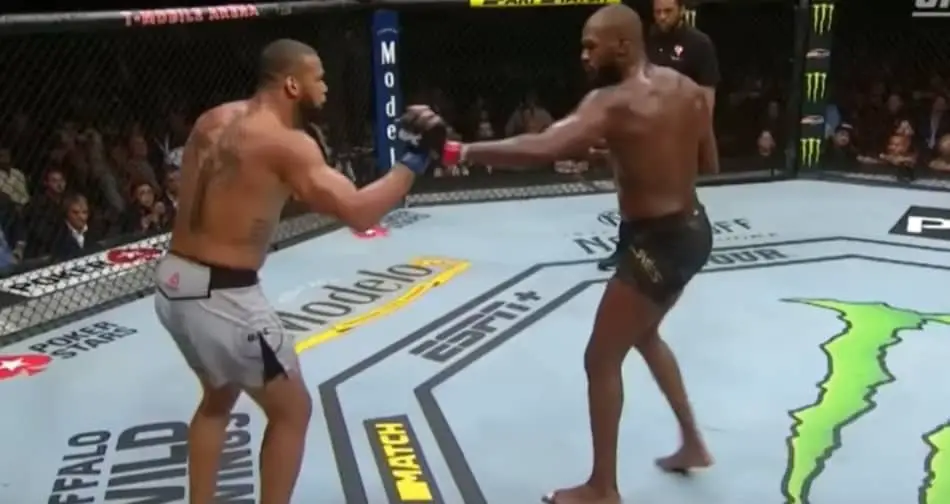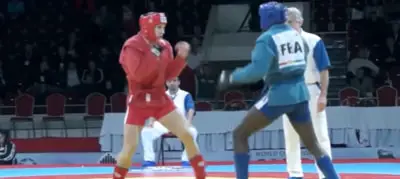
Some MMA fighters have super long reaches. Other’s have noticeably short arms. But what’s the average reach of an MMA fighter? To answer this question, I’ve calculated the average reach of the top 10 current UFC fighters of each division and put the information in this table:
| Weightclass | Reach in inches | Reach in cm |
| Heavyweight (up to 265 lb; 120.2 kg) | 78.6 | 199.6 |
| Light heavyweight (up to 205 lb; 93.0 kg) | 77.8 | 197.6 |
| Middleweight (up to 185 lb; 83.9 kg) | 74.8 | 190.0 |
| Welterweight (up to 170 lb; 77.1 kg) | 73.3 | 186.2 |
| Lightweight (up to 155 lb; 70.3 kg) | 72.4 | 183.9 |
| Featherweight (up to 145 lb; 65.8 kg) | 70.6 | 179.3 |
| Bantamweight (up to 135 lb; 61.2 kg) | 67.3 | 170.9 |
| Flyweight (up to 125 lb; 56.7 kg) | 67.5 | 171.5 |
Of all of the top 10 fighters Jon Jones (Light Heavyweight) has the longest reach – 841⁄2“. And the fighter with the shortest reach is the bantamweight and former flyweight champion Henry Cejudo – 64”.
Generally speaking, people’s height is about the same as their reach (1:1). But if take a look at the average height of an MMA fighter you’ll notice that MMA fighters reach is 2-3 inches longer than their height.
The top 10 Heavyweights have the longest reaches compared to their height (1.04:1) while the top 10 Bantamweights have the smallest reach to height ratio (1.01:1).
That can’t be compared to basketball players for example, who can have a 1:1.1 height to wingspan ratio but still MMA fighters have definitely a longer reach than average people.
That means they have eighter longer arms than average and/or broader than average shoulders. Because those two factors determine your reach.
I’ll talk about why reach is so important in MMA and in combat sports in general in a minute. But first I have to mention that there are two problems with the information in this table, which make it slightly inaccurate.
Problems with the data
I’ve got the fighters data (their reach in this case) from ufcstats.com where they tend to make small fighters taller by adding height and reach.
The other problem is that they are rounding to the nearest inch which makes a lot of fighters appear to have the same reaches while in reality, they can have more than half an inch difference.
So the real numbers are ±1 inch different from what you see in the table and for the lighter weight classes (featherweight; bantamweight and flyweight) probably -1 inch.
In the rest of the article, I’m going to talk about why the reach is so important, how fighters with long reaches utilize it and some advantages people with short reaches have.
Why MMA Fighters have Long Reach?
The shot explanation is that people with long reaches tend to do better in the sport. People with long reach usually are also taller. That means they also have long legs which allows them to kick from a far distance.
Being taller than your opponent means that your shoulders are almost at the level of his head. That is very cool because your punches have to travel a shorter path to his head than his punches (because the shortest path is the straight line).
That’s why taller fighters are so rangy. It’s not only because of their reach but because of their height. Ultimately reach + height = range.
So to answer the question of why MMA fighters on the highest levels have long reach, my theory is basically that such people tend to do well in the gym and that’s why decide to try to compete.
The other explanation is the weight cut. If you check out my article on average MMA fighter height here, you’ll understand that MMA fighters appear to be very tall for their weight because they cut a lot of weight several days before the weigh-ins.
They appear to have super long reaches for their weight for the same reason.
How is Reach Measured
The arm span or arm span is the length between the end of the arms of a person and it’s measured at the fingertips.
The length of your arms is the most important factor that determines your reach, but your shoulder width is also a factor. There are some short people with super broad shoulders which makes their reach appear longer.
That is one of the reasons why we see short MMA fighters that have a longer reach than their taller opponents (example: Jose Aldo vs Max Holloway).
But when it comes to fighting the shoulder width comes into play only if you turn your shoulders as you punch or if you are fighting sideways. If you aren’t really turning your shoulders or you are fighting in a more squared stance, the additional inches from your shoulder width doesn’t really matter.
Also since the reach is measured at the fingertips, if a fighter has super long fingers for some reason, that will affect his reach making it longer.
Which isn’t really matter because you hit with a closed fist (or at least you should hit that way) so this additional inch is useless.
Use of the Reach
Having a long reach isn’t simply enough for you to be successful in the stand-up. You also need at least one of the following: good footwork, speed, good jab (and straight punches in general).
Fighters that have all three plus long reach have high-level distance management and are very hard to get in.
If you add and good defensive skills (both striking and takedown defense), and a smart gameplan, those fighters are extremely hard to beat.
The perfect example for that is the UFC Light Heavyweight and all-time great Jon Jones. He may not be the fastest with his hands, but his reach is insane, his footwork and defense are on point which makes him super hard to hit.
On the other side of the spectrum, we have Stephan Struve who is a heavyweight and has the same exact reach as Jones but isn’t using it as nearly as effective. His footwork isn’t very good when moving back and he isn’t really jabbing that much.
That allows his opponents to get in close and nullify his reach advantage.
Strategy for fighters with short reaches
Fighters with shorter reach than their opponent can either try to close the distance and start landing some hooks/uppercuts to the body and the head or work on their takedowns, wait for their opponents and counter them from a distance or use reactive takedowns to get the fight to the ground.
Closing the distance is the obvious gameplan for short fighters with shorter reaches. I say short fighters because even if you are taller than your opponent but have shorter reach you still have a longer range of attacks because of your height.
But to closing the distance can be trying because your opponent will be expecting it and will be ready to intercept you with punches. So you need to either pressure your opponent to the cage or mix it up by disguising your takedown/clinch attempts with punches or kicks (that’s what basically wrestlers such as Khabib Nurmagomedov and Colby Covington are doing).
Staying on the outside and countering your opponent requires very good timing, speed, and precision (and an opponent willing to attack). That was basically the gameplan of Conor McGregor when he fought Nate Diaz the second time.
The last option I’m going to talk about is reactive takedowns. That’s when, for example, your opponent tries to punch you and you duck under the punch and shoot for a takedown. The more the opponent commits to the punch, the more he loses his balance which makes it easier for you to take him down.
But again, requires good timing, speed, and commitment. Many times as wrestlers are getting hurt or heavy pressured they panic and try to go for a takedown which makes it super obvious and easy to stop.



